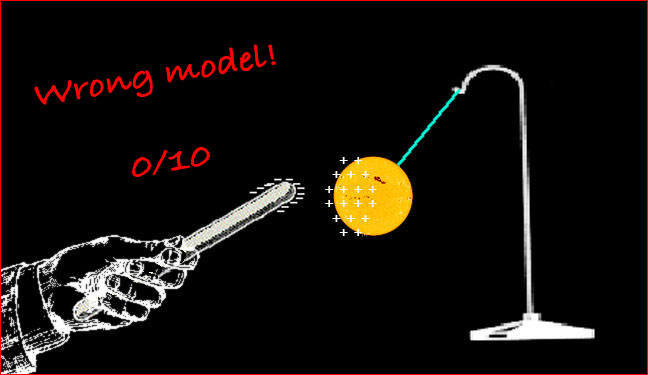
home •
about •
essential guide •
picture of the day •
thunderblogs •
news •
multimedia •
predictions •
products •
get involved •
contact
picture of the day archive subject index
Credit: Wal Thornhill
May 08, 2007
Of Pith Balls and PlasmaThe electric force is never mentioned in astronomy although it is the most powerful force in Nature. It is dismissed because simplistic electrostatic models do not match observations. Yet plasma cosmologists are able to successfully match electrodynamic models to observations without conjuring invisible matter and inventing new forces.
A common mistake when first trying to understand the Electric Universe is to think in terms of electrostatics. Experiments with pith balls in Freshman Physics Lab come to mind. With a little imagination—and by plugging larger numbers into the equations—a model of “the pith ball sun” can be constructed.
This model is not too different from the familiar gravitational model. Most of the underlying assumptions are preserved: an isolated body at equilibrium; a point force distributed spherically (decreasing with the square of the distance from the point); conditions of isotropy, continuity and homogeneity.
The central pith ball, if positively charged, will repel positive ions, generating a “wind” that accelerates away from the ball, much as is observed with the solar “wind.” And the pith ball will attract electrons: Because they are so much less massive than ions, they could be accelerated to relativistic velocities. With sufficient velocity, their collision with the pith ball could account for its luminosity.
But spacecraft have not found any relativistic electrons. And the solar wind seems to be composed of nearly equal numbers of positive ions and negative electrons. And the ions practically stop accelerating by the time they reach the orbit of the Earth. And most of the solar wind is confined to the Sun’s equatorial plane. And many more items could be listed where the pith ball model doesn’t correspond with observations.
The Electric Universe model is based on electrodynamics. And not simply on Freshman Physics electrodynamics from a textbook but on the electrical behavior of plasma as observed in laboratories and by spacecraft. Understanding actual plasma behavior requires rejecting familiar presuppositions: Bodies immersed in plasma aren’t isolated; they are connected by circuits. They often aren’t at equilibrium; most astronomical bodies are radiating energy because they are in unstable conditions and are moving toward equilibrium. Currents in plasma contract into linear filaments; and the force between filaments decreases linearly with distance, which makes it the most powerful long-range force in the universe. Plasma divides into cells that are separated by capacitor-like double layers; and this ensures that plasma phenomena are characterized by conditions of non-isotropy, discontinuity and inhomogeneity.
Assumptions and deductions imported from the “already known” of gravitational theory will lead to confusion and absurdity. As astronomer Halton Arp said in another context: “Sometimes it’s better not to know one wrong thing than to know a hundred things that are right.” The first step in understanding electricity in space is to set aside theories and to gain empirical familiarity with real plasma behavior. It is a step advocated by the father of plasma physics, Hannes Alfvén, in his 1970 Nobel Prize acceptance speech.
![]()
home •
thunderblogs •
forum •
picture of the day •
resources •
team •
updates •
contact us
EXECUTIVE EDITORS:
David Talbott, Wallace Thornhill
MANAGING EDITORS:
Steve Smith, Mel Acheson
CONTRIBUTING EDITORS: Michael Armstrong, Dwardu Cardona,
Ev Cochrane,
C.J. Ransom, Don Scott, Rens van der Sluijs, Ian Tresman
WEBMASTER: Brian Talbott
Copyright 2007: thunderbolts.info
